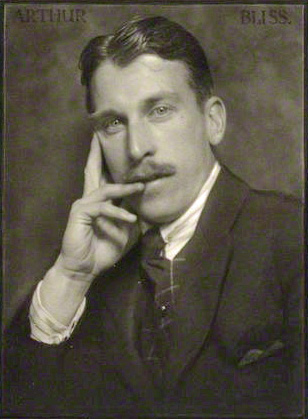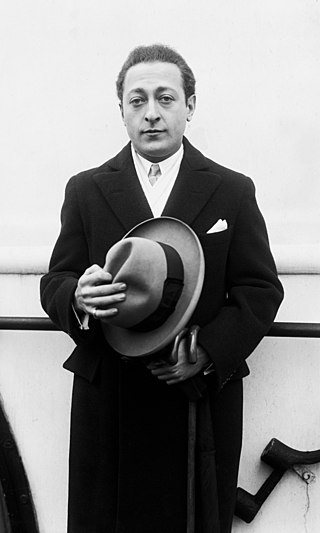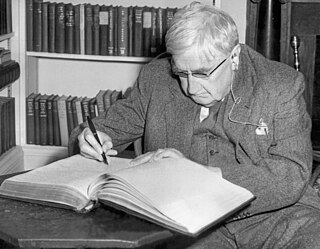Notes, references and sources
Notes
- ↑ CD recordings conducted by André Previn, Bryden Thomson and Edward Gardner take 16m 9s, 15m 17s, and 13m 34s respectively. [6]
Related Research Articles

Edward Benjamin Britten, Baron Britten was an English composer, conductor, and pianist. He was a central figure of 20th-century British music, with a range of works including opera, other vocal music, orchestral and chamber pieces. His best-known works include the opera Peter Grimes (1945), the War Requiem (1962) and the orchestral showpiece The Young Person's Guide to the Orchestra (1945).

Sir William Turner Walton was an English composer. During a sixty-year career, he wrote music in several classical genres and styles, from film scores to opera. His best-known works include Façade, the cantata Belshazzar's Feast, the Viola Concerto, the First Symphony, and the British coronation marches Crown Imperial and Orb and Sceptre.

Sir Arthur Edward Drummond Bliss was an English composer and conductor.

The Violin Concerto by William Walton was written in 1938–39 and dedicated to Jascha Heifetz, who commissioned the work and performed it at its premiere on 7 December 1939 with the Cleveland Orchestra conducted by Artur Rodziński. The British premiere, delayed by the Second World War, was given on 1 November 1941, with Henry Holst as soloist and the composer conducting. Walton later reorchestrated the concerto; the revised version was premiered in 1944. The work has been frequently recorded and has established itself as one of the composer's most durable compositions.
The Viola Concerto by William Walton was written in 1929 and first performed at the Queen's Hall, London on 3 October of that year by Paul Hindemith as soloist and the composer conducting. It had been written with the violist Lionel Tertis in mind, and he took the work up after initially rejecting it. The concerto established Walton as a substantial figure in British music and has been recorded by leading violists internationally. Walton revised the instrumentation of the concerto in 1961, lightening the orchestral textures.
The Young Person's Guide to the Orchestra, Op. 34, is a 1945 musical composition by Benjamin Britten with a subtitle Variations and Fugue on a Theme of Purcell. It was based on the second movement, "Rondeau", of the Abdelazer suite. It was originally commissioned for the British educational documentary film called Instruments of the Orchestra released on 29 November 1946, directed by Muir Mathieson and featuring the London Symphony Orchestra conducted by Malcolm Sargent; Sargent also conducted the concert première on 15 October 1946 with the Liverpool Philharmonic in the Philharmonic Hall, Liverpool, England.

Josef Alois Krips was an Austrian conductor and violinist.

Ralph Vaughan Williams's Symphony No. 8 in D minor was composed between 1953 and 1955. Sir John Barbirolli, its dedicatee, conducted the Hallé Orchestra in the premiere at the Free Trade Hall in Manchester on 2 May 1956. It is the shortest of the composer's nine symphonies, and is mostly buoyant and optimistic in tone.
The Symphony No. 2 by William Walton was written between 1957 and 1960, and premiered in September 1960. It received a mixed reception at first: some critics thought Walton's music old-fashioned. Subsequently it has been re-evaluated and praised. The work was first performed by the Royal Liverpool Philharmonic Orchestra, conducted by John Pritchard and was first recorded by the Cleveland Orchestra, conducted by George Szell. It has subsequently been recorded by conductors from Britain, the US and elsewhere.
Sinfonia da Requiem, Op. 20, for orchestra is a symphony written by Benjamin Britten in 1940 at the age of 26. It was one of several works commissioned from different composers by the Japanese government to mark Emperor Jimmu's 2600th anniversary of the founding of the Japanese Empire. The Japanese government rejected the Sinfonia for its use of Latin titles from the Catholic Requiem for its three movements and for its somber overall character, but it was received positively at its world premiere in New York on 29 March 1941 under John Barbirolli. A performance in Boston under Serge Koussevitzky led to the commission of the opera Peter Grimes from the Koussevitzky Music Foundations.
The Symphony No. 1 in B♭ minor is one of two symphonies by the English composer William Walton. The composer had difficulty in completing the work, and its first public performance was given without the finale, in 1934. The complete four-movement work was premiered the following year.

The Bear is the second of the two operas by William Walton, described in publication as an "Extravaganza in One Act". The libretto was written by Paul Dehn and Walton, based on the play of the same title by Anton Chekhov.
Variations on an Elizabethan Theme is a set of variations for string orchestra, written collaboratively in 1952 by six English composers: Lennox Berkeley, Benjamin Britten, Arthur Oldham, Humphrey Searle, Michael Tippett and William Walton.
William Walton's Cello Concerto (1957) is the third and last of the composer's concertos for string instruments, following his Viola Concerto (1929) and Violin Concerto (1939). It was written between February and October 1956, commissioned by and dedicated to the cellist Gregor Piatigorsky, the soloist at the premiere in Boston on 25 January 1957.
Roderick Gregory Coleman Williams OBE is a British baritone and composer.
Benjamin Britten's Piano Concerto, Op. 13, is the composer's sole piano concerto.

Scapino is a short work for large orchestra by William Walton, described by the composer as a "comedy overture". It was commissioned by the Chicago Symphony Orchestra and was first performed in 1941. A revised version was premiered in 1950.
William Walton's Variations on a Theme by Hindemith is an orchestral piece in eleven continuous sections, first performed in 1963. It is a tribute to Walton's friend and fellow composer Paul Hindemith.
William Walton's Partita for Orchestra is a three-movement work for large orchestra, composed for, dedicated to and first performed by the Cleveland Orchestra and its conductor George Szell. The work was composed in 1957 and premiered on 30 January 1958.
Siesta is a short piece for small orchestra, written by William Walton and premiered in 1926. It was later used for a ballet by Frederick Ashton. Walton was a devotee of Italy, and its influence is apparent in this work.
References
- 1 2 3 Kennedy, p. 214
- 1 2 3 4 5 6 7 Burton, Anthony (2015). Notes to Chandos CD CHSA 5153 OCLC 914132812
- 1 2 Sadie, Stanley. "Bang On", The Times, 29 June 1970, p. 11
- 1 2 Kennedy, p. 243
- ↑ "Improvisations on an Impromptu of Benjamin Britten", Oxford University Press. Retrieved 4 February 2019
- ↑ OCLC 29818111, OCLC 594611923 and OCLC 914132812
- 1 2 3 Kennedy, p. 242
- ↑ Greenfield, Edward. "Walton's 'Improvisations' at Aldeburgh", The Guardian, 29 June 1970, p. 8
- ↑ "Improvisations on an Impromptu of Benjamin Britten, for orchestra (1969)", The Walton Trust. Retrieved 4 February 2019
- ↑ Notes to RCO CD set RCO 06004 (2004) OCLC 981368034
- ↑ Chandos CD CHSA 5153 OCLC 914132812
Sources
- Kennedy, Michael (1989). Portrait of Walton . Oxford: Oxford University Press. ISBN 978-0-19-816705-1.